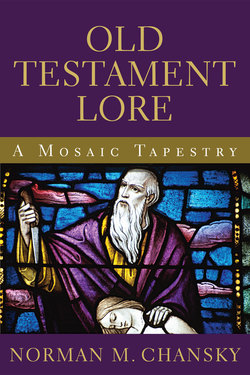Читать книгу Old Testament Lore - Norman M. Chansky - Страница 6
Foreword
ОглавлениеHumans have always wondered about the mysteries of the universe as well as the unique history of their people. They ask what does my world consist of? How did it come about? They also seek to understand themselves, to know their personal stories, to find their place in the universe. Ancestors shaped their outlook on life;. humans wish to know how. For many of us the answer begins with Creation and continues through The Flood, the Patriarchs, and the Prophets.
However, each culture has its own creation story to fix its place in history and to define its destiny. It is hard to find a culture that does not evoke the divine.That story gives a culture its unique signature. According to a Crow Indian legend, in the beginning there was only water and ducks. Then the Sun, the Creator, merged with the Coyote. The Creator told the ducks to dive into the water and from the mud on their webbed feet the Earth was created and peopled. Early Egyptians explained that dry land appeared out of a primordial ocean. Atum, the Sun god- later named Ra, father of all other gods, arose from an abyss. In Mesopotamia, creation also took place from a watery abyss, Apsu. But the world came into being from a violent clash between older and younger gods. Marduk, made the sky and earth from two halves of the body of Tiamat, a dragon personifying evil. In Persian cosmology, Ahura Mazda was the creator of Man as well as the decider and ruler of natural events such as the course of the moon. Good and Evil, twin attributes of his character, contend for supremacy. In the end virtue defeats evil. The gods of the Greek and Roman pantheons go by the names of Zeus and Jupiter respectively. But neither were creators. Rather according to Greek mythology the world begins with Chaos, a vast void surrounded by water, the domain of Eurynome, the goddess of all things. She coupled with a snake and gave birth to Eros. Eurynome separated the sky from the sea. Out of that relationship was born Gaia, Mother Earth, and Uranus, the Heavens. Gaia married Uranus and gave birth to the Titans, the most important of which was Cronus who married Rhea but then swallowed all of their children. Only Zeus survived by a trick devised by Gaia.
Compare these stories with an aboriginal creation myth. In the beginning all was still. All of the spirits of the earth were asleep. Then the Father of all Spirits stirred and woke up the Sun Mother who was bidden to go down to earth and awaken all of the spirits. Her light spread across the earth, melted ice which became oceans, rivers, and lakes. She penetrated into caves and wakened insects. These in turn combined with flowers of every color imaginable. She enjoined all creatures in the cosmos to live in peace with one another. Then she returned to the sky.
In sharp contrast is the Hebrew story of Creation. There is only one God Who Created the cosmos, by fiat, through words not brutality, trickery, or coaxing. “Let there be light!” This is how the Creation account of the Hebrews begins. Although the heavens and earth were Created from an abyss, it was the Spirit of God that Hovered over the deep dividing light from darkness. God is in complete control of the Creative process: day, night, vegetation, lower animals and higher animals. Man is Created with the mandate to protect all manner of life. Then on the seventh day God Rested and Gave the Sacred Sabbath to humanity. The Sacred Sabbath is also a Mandate.
Genesis is said to present two accounts of Creation: the P or priestly account (Gen I and II, 1–4) and the J account (Gen II 4b-24). There are several differences between them. In the former God is called “Elohim”; in the latter, the ineffable name yood, hay, vav, hay is sometimes transliterated “Yahweh.” In the former, animals were Created before Man; in the latter, after Man. In the former, man and woman were Created simultaneously; in the latter, woman was taken from Adam’s rib. These dual accounts are not isolated instances but templates for other narrations. There are multiple versions of the same “event” giving The Bible an aura of the recondite. Reconciling the versions and finding the deeper meanings of single accounts has been an undertaking of scholars of many faith communities for many centuries. Scholars extract meaning through the special blueprint that charts their courses. All readers delve into the sacred text and map their own meanings in an effort to define who were their ancestors, who they are now and who they seek to become.
Our knowledge of the past is ever expanding; the meanings we derive from the Old Testament, therefore, alter as well.
